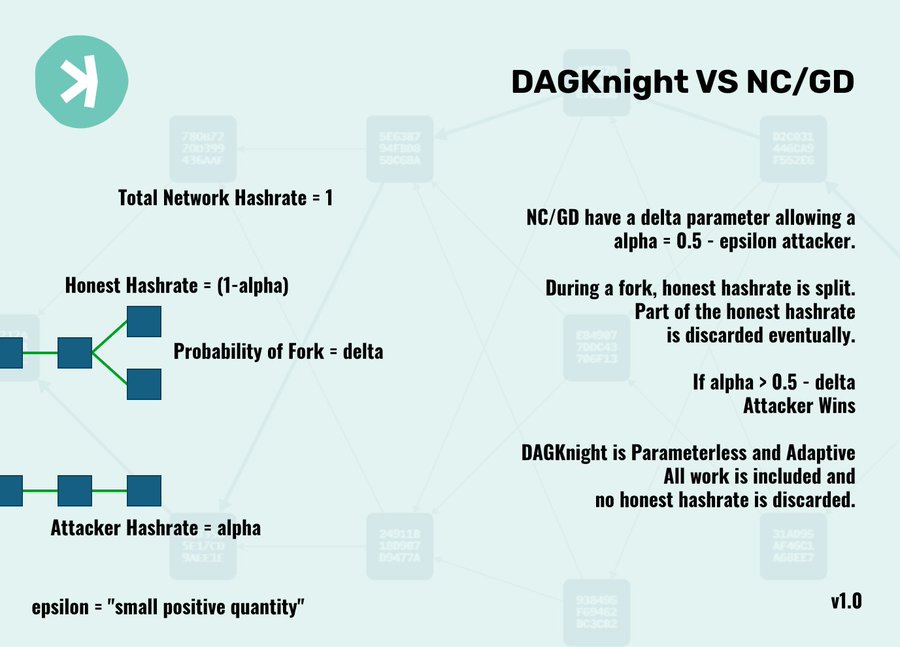Research
Where are Kaspa’s White Papers?
Here are valuable resources for research:
GhostDAG White Paper
https://research.kas.pa
DAGKnight White Paper
What is GhostDAG?
GHOSTDAG allows us to make a chain out of the parallel blocks in the BlockDAG, which results in the same security guarantees provided by Nakamoto consensus (bitcoin), but with increased throughput and lower confirmation times.
For more information, read: https://kaspa.org/what-is-ghostdag-and-dagknight/
Where can I read community-driven information?
Kaspa Wiki - Kaspa is a community project, completely open source, no central governance, no business model.
Where can I find debunked myths about Kaspa?
Discover the truth about Kaspa at https://kasparchive.com/
What happens to Kaspa and Bitcoin when quantum computers are viable?
https://arxiv.org/abs/1710.10377 - Quantum attacks on Bitcoin, and how to protect against them
https://arxiv.org/abs/1804.08118 - On the insecurity of quantum Bitcoin mining
https://arxiv.org/abs/2403.08023 - 51% Attack via Difficulty Increase with a Small Quantum Miner
What is DAGKnight?
Michael Sutton and Yonatan Sompolinsky are working on a new ordering mechanism called DAGKNIGHT where the confirmation time adapts automatically by the internet speed. This means any improvement in the network conditions of the miners and any optimization in the block validation algorithm will also speed up the confirmation time.
DAGKNIGHT (DK) is a new consensus protocol, written by the authors of this KIP, that achieves responsiveness whilst being 50%-byzantine tolerant. It is therefore faster and more secure than GHOSTDAG (GD), which governs the current Kaspa network. In DK there’s no a priori hardcoded parameter k, and consequently, it can adapt to the “real” k in the network. Concretely, in DK, clients or their wallets should incorporate k into their local confirmation policy of transactions (similarly to some clients requiring 6 confirmations in Bitcoin, and some 30 confirmations). (Source: https://github.com/kaspanet/kips/blob/master/kip-0002.md)

Infographic source: https://x.com/KaspaFacts/status/1895452419229892693
DAGKNIGHT White Paper:
The DAG KNIGHT Protocol: A Parameterless Generalization of Nakamoto Consensus
Articles:
What is GHOSTDAG and DAGKNIGHT?
The Master of Time: How DAGKNIGHT Solves an Impossibility Result Unachievable by Bitcoin, Ethereum and Classical BFT Models
The DAG KNIGHT Protocol — Elevating Kaspa
The Rise of DAG Knight: A Protocol in Shining Armor
Video Explanations:
What is DAGKNIGHT? (Short explanation by Kaspa Founder, Yonatan Sompolinsky)
DAG Knight presentation - CESC Day 1 w/ Yonatan Sompolinsky
Kaspa Ghostdag 101 (Presented by Shai (Deshe) Wyborski)
Kaspa Coin DAGKNIGHT Explained
What Is DAGKnight And GhostDAG?
What is DAGKNight?
Kaspa's Protocol Explained Evolution From GHOST to DAGKNIGHT
Kaspa's DAGKNIGHT Explained
Kaspa's Endgame: How DAGKNIGHT Revolutionizes Crypto
How do we verify the first block, and what address was it mined to?
The genesis block is hard-coded.
@coderofstuff_ published a guide with directions on how to verify the integrity of the Kaspa chain here:
https://github.com/kaspagang/kaspad-py-explorer/blob/main/src/genesis_proof.ipynb
According to Gonzo, "Genesis blocks are not mined. They are hard-coded into every blockchain. That’s why they have no coinbase reward and no payout address. Their purpose is to give every node an identical starting point. Bitcoin’s genesis is the same: it wasn’t mined. It was manually defined in the source code with a fixed hash, timestamp, and coinbase data. Kaspa follows the same model. The genesis block is set in code and identical for everyone. So if you’re looking for an 'address' that received coins, it doesn’t exist. No coins were ever minted in Kaspa’s genesis. What matters is the fixed hash, which every node validates from. That’s a cryptographic rule. Kaspa’s genesis also carries an inscription. In Hebrew, it reads: 'Whatever seems good to you and according to the will of your God.'"
Here is the hash you’re after:
caeb97960a160c211a6b2196bd78399fd4c4cc5b509f55c12c8a7d815f7536ea
@hashdag further clarified in a published article here:
https://hashdag.medium.com/in-which-mayday-mayday-we-are-syncing-about-bf05ad58957a
@Potat said, "From where I see it, the verification process is pretty much the same as verifying a block solution, but for each pruning point proof hash you can verify the validity of the UTXO set (by showing it originated from an empty set)."
 |
